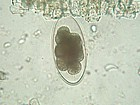Difference between revisions of "Nematodirus"
| (5 intermediate revisions by the same user not shown) | |||
| Line 1: | Line 1: | ||
| − | {{ | + | {{OpenPagesTop}} |
| − | |||
{{Taxobox | {{Taxobox | ||
|name = Nematodirus spp. | |name = Nematodirus spp. | ||
| Line 14: | Line 13: | ||
|species = | |species = | ||
}} | }} | ||
| − | + | Also known as: '''''Thread-necked worm | |
| − | |||
| − | |||
| − | |||
| − | |||
| − | |||
==Introduction== | ==Introduction== | ||
| Line 27: | Line 21: | ||
It is a nematode, and is part of the [[:Category:Trichostrongyloidea|''Trichostrongyloidea'']] superfamily. | It is a nematode, and is part of the [[:Category:Trichostrongyloidea|''Trichostrongyloidea'']] superfamily. | ||
| − | + | Predilection site: '''Small intestine | |
| − | |||
| − | |||
| − | |||
| − | |||
==Hosts== | ==Hosts== | ||
| Line 52: | Line 42: | ||
''N. battus'' can only hatch from eggs excreted on to pasture in the previous year. | ''N. battus'' can only hatch from eggs excreted on to pasture in the previous year. | ||
| − | [[Nematodirosis - Sheep]] | + | <big>'''[[Nematodirosis - Sheep]]</big> |
| − | [[Category:Trichostrongyloidea]] | + | |
| − | [[Category: | + | {{Learning |
| − | [[Category:Expert_Review]] | + | |literature search = [http://www.cabdirect.org/search.html?rowId=1&options1=AND&q1=Nematodirus&occuring1=title&rowId=2&options2=AND&q2=&occuring2=freetext&rowId=3&options3=AND&q3=&occuring3=freetext&x=76&y=4&publishedstart=yyyy&publishedend=yyyy&calendarInput=yyyy-mm-dd&la=any&it=any&show=all ''Nematodirus'' publications] |
| + | }} | ||
| + | |||
| + | |||
| + | {{review}} | ||
| + | |||
| + | {{OpenPages}} | ||
| + | |||
| + | [[Category:Trichostrongyloidea]][[Category:Sheep Nematodes]] | ||
| + | [[Category:Expert_Review - Parasites]] | ||
Latest revision as of 22:12, 2 August 2012
| Nematodirus spp. | |
|---|---|
| Class | Nematoda |
| Super-family | Trichostrongyloidea |
Also known as: Thread-necked worm
Introduction
N. battus is most prominent within the UK, but is also present to a lesser extend in Norway, Sweden, the Netherlands, and Canada. In heavy infections this parasite can be severe, and if left untreated can lead to the death of the carrying host. It is also capable of causing parasitic catarrhal enteritis.
It is a nematode, and is part of the Trichostrongyloidea superfamily.
Predilection site: Small intestine
Hosts
Mainly sheep and goats, but infected cattle are occasionally found.
Identification
A mature adult is around 2cm longer. The female has a prominent spine projecting from the end. The male has a very long slender tail with spicules extended past the bursa.
N. battus eggs are larger than the typical egg of a Trichostrongyle, and have a brownish colouration, with parallel sides.
Life Cycle
The lifecycle of N. battus is different from the common Trichostrongyle lifecycle.
L1-L3 occurs within the egg. The larvae takes several months to develop. Hatching is stimulated by a cold period followed by a night/day temperature of around 10 degrees. The L3 are highly susceptible to changes in climate, so must be ingested soon after moulting to ensure the success of infection.
Pathology is seen when large number of larvae inhabit the small intestine.
N. battus can only hatch from eggs excreted on to pasture in the previous year.
| Nematodirus Learning Resources | |
|---|---|
 Search for recent publications via CAB Abstract (CABI log in required) |
Nematodirus publications |
| This article has been peer reviewed but is awaiting expert review. If you would like to help with this, please see more information about expert reviewing. |
Error in widget FBRecommend: unable to write file /var/www/wikivet.net/extensions/Widgets/compiled_templates/wrt694adbeb0ca464_17644410 Error in widget google+: unable to write file /var/www/wikivet.net/extensions/Widgets/compiled_templates/wrt694adbeb16c790_40001971 Error in widget TwitterTweet: unable to write file /var/www/wikivet.net/extensions/Widgets/compiled_templates/wrt694adbeb2265c1_69276816
|
| WikiVet® Introduction - Help WikiVet - Report a Problem |
